Affordable Grow Lights for Thriving Indoor Plants
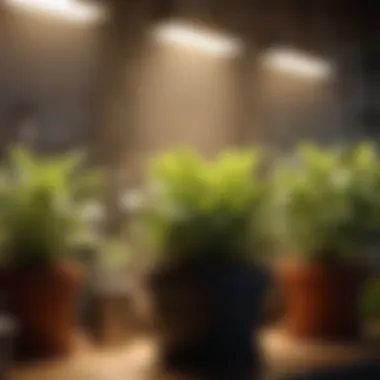
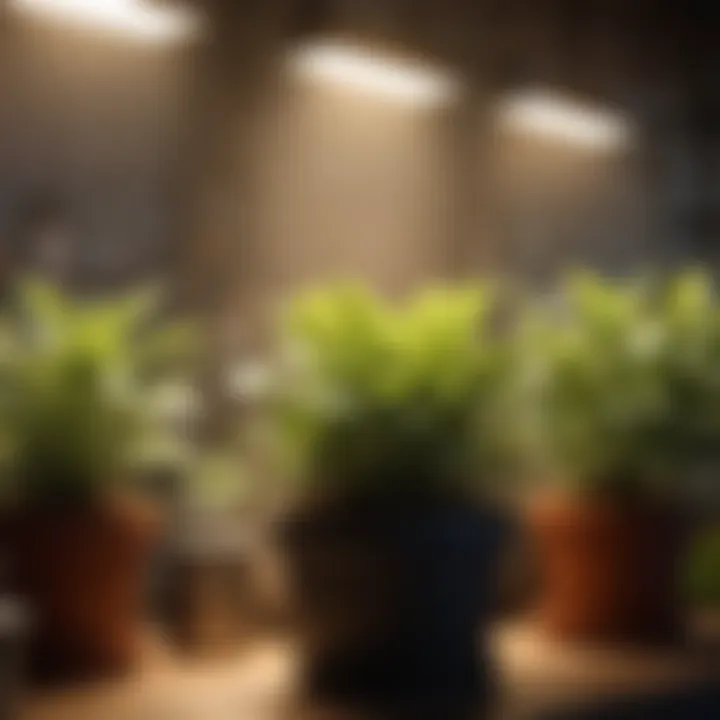
Intro
As indoor gardening makes its mark on modern living, the necessity for the right tools becomes clear. Plants, much like people, require the right environment to flourish. This has created a growing interest in grow lights—a beacon of hope for those who seek to cultivate their green thumb inside their homes. Choosing an affordable grow light can be confusing, given the multitude of options available, each promising to be the miracle solution for plant vitality.
In this article, we will navigate the often convoluted world of grow lights tailored for indoor plants, highlighting budget-friendly options without cutting corners on efficiency or effectiveness. The mission is to empower every hobbyist gardener and plant enthusiast with vital knowledge and practical tips. We will address the different types of grow lights, weigh their pros and cons, and arm you with insights to select the ideal lighting for your plant collection—all while keeping your wallet intact.
"A well-placed light can turn a neglected corner into a thriving oasis."
Whether you’re nurturing succulents on a windowsill or launching a mini greenhouse in your apartment, this guide is here for you. So, roll up your sleeves and get ready to uncover the essentials of indoor plant illumination, ensuring your leafy companions have every chance to thrive in their new environment.
Understanding Grow Lights
When it comes to nurturing plants indoors, the right lighting can mean the difference between a thriving green sanctuary and a wilted disappointment. In our modern age, especially for those of us juggling family and household responsibilities, understanding grow lights becomes a vital part of our gardening toolkit. These lights provide a convenient solution to the limitations of natural sunlight, especially during those long winter months or in spaces lacking sufficient windows.
What Are Grow Lights?
Grow lights are artificial lights specifically designed to promote plant growth. They imitate sunlight by emitting a spectrum of light that plants need for photosynthesis. This goes beyond just illuminating a space for aesthetic reasons—it’s about creating an artificial sun that ensures your leafy buddies get the nutrients they thrive on.
Different types of grow lights cater to various plant needs, growth stages, and environments. For example, some plants might flourish under blue light, which helps with vegetative growth, while others might bask in red light, instrumental for flowering. Home gardeners often find themselves on a quest to choose the best light for their green companions without shaking their budget.
How Grow Lights Function
Understanding how grow lights function is essential for usage optimization. In simple terms, grow lights work by generating light that mimics the natural growth cycle of plants. They convert electrical energy into light energy, which plants then use to photosynthesize, producing food and energy necessary for growth.
Several factors contribute to how effective a grow light is:
- Light Spectrum: Different light wavelengths influence plant processes. Blue light (400-500nm) is ideal for vegetative growth, while red light (600-700nm) benefits flowering and fruiting.
- Intensity and Duration: The more intense the light, the more energy your plant absorbs. Moreover, timing matters; keeping lights on for about 12 to 16 hours, depending on the plant type, is commonly suggested.
- Heat Production: It's worth noting that some lights generate heat, which can be a double-edged sword. Adequate warmth can promote growth, but excessive heat may stress your plants, leading to wilting or burning.
In summary, purchasing grow lights isn’t a mere formality; it calls for thoughtful consideration. By grasping what grow lights are and how they function, you empower yourself to make informed decisions that will nurture delightful indoor gardens all year round.
Types of Grow Lights
In the journey of cultivating indoor plants, selecting the right grow light can be a game-changer. "Types of Grow Lights" serves as the backbone for understanding how to tailor light conditions that match the needs of different plants. Each type of grow light possesses distinct characteristics that cater to diverse gardening styles and budgets. Ultimately, having a solid grasp of grow light varieties enables better growth, health, and blooming of indoor plants, while ensuring that expenses are kept within manageable limits.
LED Grow Lights
Benefits of LED Technology
LED lights have transformed the landscape of indoor gardening. One significant aspect of LED technology is efficiency. They produce light with minimal heat output, which means plants receive optimal lighting without the risk of overheating. Additionally, they have a long lifespan, often exceeding 50,000 hours, making them a cost-effective option in the long run. This has made LEDs a popular choice among conscientious gardeners seeking sustainability.
The unique feature of LED grow lights is their flexibility in light spectrum. By emitting specific wavelengths, they can be tailored to meet the exact needs of plants at various growth stages. Therefore, whether you are sprouting seedlings or nurturing mature plants, LED lights adapt accordingly.
Considerations When Choosing LED Lights
When pondering over Considerations When Choosing LED Lights, the need for compatibility with your plant types and space cannot be overstated. It’s essential to understand what spectrum works best for your specific plants. Different species may require different spectrums – for instance, flowering plants often thrive under red light during bloom stages.
A key characteristic of LED grow lights is initial cost. While the up-front price may appear steep compared to other types, remember, they save you money over time due to energy efficiency. Cost-benefit analysis should guide your decision. Remember also the advantage of dimmability, as many LEDs come with this feature. Dimmers allow flexibility in light intensity and can prevent light burn, thus nurturing healthy growth.
Fluorescent Grow Lights
Types of Fluorescent Lights
Fluorescent lights are an old favorite in the indoor gardening community for their accessibility and versatility. There are generally two primary types: T5 and T8. T5 lamps are more efficient, boasting higher lumens per watt compared to T8 lamps, making them ideal for plant growth. However, T8 lights are also effective and may be more widely available.
The unique feature of fluorescent grow lights is their broad coverage area. They distribute light evenly, which is especially useful in setups with multiple plants. Mostly, these lights produce less heat, making them suitable for delicate plants or those requiring lower temperatures.
Where to Use Fluorescent Lights
One of the great aspects of Where to Use Fluorescent Lights is their adaptability. They work well in various settings, including small indoor spaces and larger plant nurseries. If you have a kitchen window with low natural light, setting up a few fluorescent lights above herb pots is a good strategy.
In terms of favorable conditions, fluorescent lights are magnified in effectiveness when used in enclosed or semi-enclosed spaces, where light concentration can lead to certain success. The overall advantage is lower energy costs and minimal heat emissions. However, remember that their disadvantage lies in the shorter lifespan compared to LEDs.
Incandescent Grow Lights
Limitations of Incandescent Options
Incandescent grow lights can seem appealing due to their low cost and easy availability. However, there are considerable limitations to acknowledge. For starters, they do not offer optimal light spectrum for plant growth; their warmth may not benefit all plants. Hence, using them can lead to underwhelming results. They also tend to be inefficient, converting a significant amount of energy to heat instead of useful light.
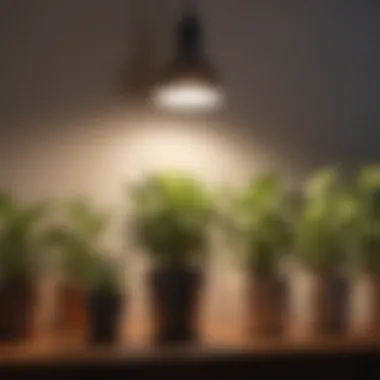
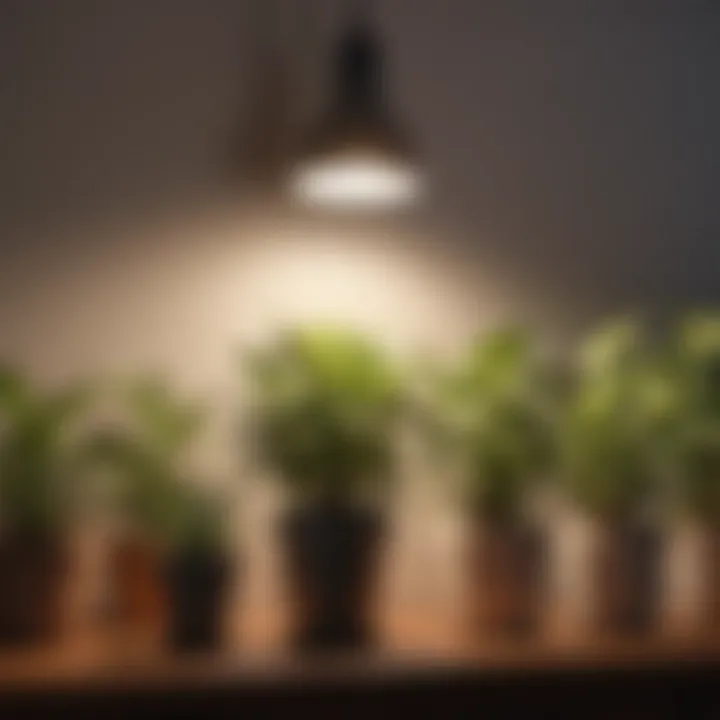
The key characteristic of incandescent options is their low initial price, but beware of higher electricity costs over time. Many indoor growers quickly discover that the long-term limitations outweigh the charm of the lower upfront cost.
Optimal Use Cases
In considering Optimal Use Cases, incandescent lights might have a place in specific scenarios—like supporting nighttime lighting for nocturnal plants. Their warm glow can simulate sunset or evening conditions beneficial for certain species.
However, it's crucial to use them cautiously. The advantage here is their ease in creating specific light-setting conditions. Still, given the disadvantages, they are best suited for supplemental light rather than primary light sources for most indoor plants.
HID Grow Lights
Overview of HID Systems
High-Intensity Discharge (HID) systems are noteworthy in the world of indoor gardening for their bright output and ability to cover large areas. They consist of types like Metal Halide (MH) and High-Pressure Sodium (HPS) lights. HID systems are effective for generating the strong light needed by larger plants or more expansive setups.
Their key characteristic lies in their power: these lights deliver high lumen output, which can facilitate rapid plant growth without sacrificing health. However, they are not without their drawbacks. They generate more heat, which can raise the temperature of your growing environment.
Efficiency and Cost Considerations
When evaluating the Efficiency and Cost Considerations with HID systems, some balancings come into play. Their high light output can produce wonderful results, but they consume more energy than LEDs or fluorescents, leading to higher utility bills.
Efficiency over time can be a concern. Although the initial costs may seem manageable, considering the amount spent on electricity over the course of their lifespan can be surprising. Make your decisions based on a thorough analysis of your specific gardening goals and possible energy costs.
Choosing the Right Grow Light
Choosing the appropriate grow light is vital when tending to indoor plants, especially when we aim to stay within a budget. The right light can make all the difference in how well plants thrive, and certain factors come into play that need careful consideration. One important aspect is the light spectrum, which refers to the wavelengths emitted by the grow light. Different plants require different spectrums for optimal growth. For instance, leafy greens may not need as intense a spectrum as flowering plants. Hence, understanding the specific needs of your plants ensures healthier growth outcomes and helps in targeting cost-effective options.
Selecting lights that fit your space and the plant's needs can drive up growth and lessen energy costs. Efficiency matters; not every grow light on the market offers the same value for your dollar. Finding the right balance between price, effectiveness, and the specific light needs of plants streamlines the process. A thoughtful choice prevents both wasted energy and money, making that green thumb shine even brighter.
Light Spectrum Needs of Plants
Photosynthesis Basics
At the heart of plant growth lies photosynthesis. This remarkable process enables plants to convert light energy into chemical energy, sustaining their life and promoting growth. Plants have evolved to use specific wavelengths of light—most notably red and blue light—to thrive. Understanding this basic principle of photosynthesis is essential because it gives insight into what your plants need. Using grow lights tailored to these wavelengths can significantly enhance their growth potential, acting as a treasure map to success.
A key characteristic here is that these wavelengths stimulate different plant processes; for example, blue light encourages strong vegetative growth, while red light is crucial during flowering. However, should one choose a light that lacks these spectrums, plants may suffer from stunted growth or poor yields. It underscores the importance of quality when selecting grow lights but at the same time clarifies that it doesn’t need to break the bank.
Growth Stages and Light Spectrum
Different plants go through various growth stages, and each stage requires a tailored light spectrum to support the developmental process. Early growth stages typically favor a more balanced blue spectrum, while flowering and fruiting calls for increased red light. This understanding can dramatically affect yield and quality, both critical for any plant enthusiast looking to cultivate success on a budget.
The unique aspect of this consideration is recognizing when and how to adjust the light spectrum as plants mature. Not all grow lights provide flexibility in this regard. Thus, when purchasing, consider those that allow for spectrum tuning or have a suitable ratio designed for both stages. This adaptability aids in gaining the most from your plants while ensuring your investment remains fruitful without unnecessary upgrades.
Assessing Light Levels
Measuring Light Intensity
Light intensity is a crucial factor in ensuring that your indoor plants receive adequate energy for photosynthesis. The measurement of light intensity usually relies on specific tools, such as a light meter, which provides readings necessary for determining whether a grow light is suitable for your plant's needs. In simple terms, too little light can leave plants weak, while too much can scorch delicate leaves.
Recognizing the key characteristic of light intensity, it’s evident that utilizing the right measuring techniques can save time, money, and heartache. Home gardeners looking to optimize their indoor gardens should get accustomed to the various scales for measuring light, which can range from lux to foot-candles. Each offers insights into how to light a plant effectively based on its specific needs.
Lumens and Foot Candles Explained
Now, let’s break down two common terms you’re likely to encounter when assessing light: lumens and foot candles. Lumens refer to the total amount of visible light emitted by a source, while foot candles measure light intensity at a distance of one foot. Both measurements have their significance in determining lighting adequacy for plants.
In practical terms, understanding these units helps you avoid overdoing it with lighting or, conversely, losing out on essential light exposure. For instance, a certain plant may thrive under 200–400 foot-candles during its growth stage, which typically avoids excess and achieves the perfect illumination balance. Thus, incorporating nuanced metrics like lumens and foot candles into your decisions not only enhances plant health but also keeps your costs in check by curtailing energy waste.
Space Considerations
Size of the Grow Area
When preparing your indoor garden, the size of your space is an essential consideration. Knowing this allows you to select grow lights that fit not only the number of plants you aim to cultivate but also how much coverage each light can effectively provide. It is worth noting that smaller grow areas don’t require powerful, high-output lights; well-chosen lights can make an equal impact without overspending.
The unique feature here is that various light types come with different coverage capacities. For instance, a compact LED light may be suitable for a small cupboard garden, while broader areas might require multiple light sources. This strategic decision ensures all plants receive optimal exposure and energy, maximizing growth potential without unnecessary complications.
Plant Height and Light Placement
Lastly, understanding your plants’ height and appropriate light placement is a contributing factor to successful indoor gardening. Positioning your grow light too high may result in inadequate light exposure, while placing it too low could cause damage. Ideally, plants should be placed at a distance where light intensity matches their growing attitude, meaning adjustments may be necessary as they mature.
The important characteristic here is the flexibility of light placement. It’s beneficial to use adjustable mounts for lights or even hanging setups, allowing easy access to position adjustments. This approach guarantees that as plants grow, they aren’t stifled or burned by inconsistent lighting. Balancing height and placement is a straightforward yet often overlooked factor when optimizing indoor gardening on a budget.
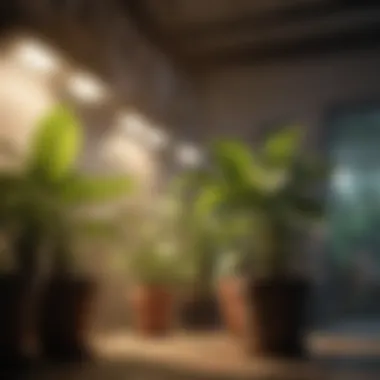

Best Affordable Grow Lights
When it comes to nurturing indoor plants, finding suitable grow lights on a budget can be quite the balancing act. The right lighting not only influences the growth of your greenery but also assists in providing a thriving environment, especially when natural sunlight is lacking. In this section, we dive into several categories of affordable grow lights, examining notable products across different types, making it easier for plant parents to choose the right fit without breaking the bank.
Notable LED Grow Light Products
Product A: Key Features
Let me introduce you to the Mars Hydro TS 600, a popular choice in the LED category. This grow light offers an impressive light spectrum that closely mimics sunlight, which is crucial for plant health. The key characteristic of the TS 600 is its energy efficiency. At just 100 watts, it provides enough light for a small grow area, allowing you to save on your electric bill while keeping those greens happy.
One unique aspect of this product is its full spectrum capability. It includes a mix of red, blue, and white lights, which combined, support all stages of growth from seedling to flowering. Users rave about its performance, noting that plants grow much faster under this light compared to others. However, while it heats up relatively less than traditional options, you still want to ensure the light is positioned at least 12 inches above your plants to prevent any potential sunburn.
Product B: User Reviews
Next up is the VIVOSUN 600W LED Grow Light. Many users have flocked to this product for its versatility and user-friendliness. The key characteristic here is its affordability, making it an attractive option for those just starting out in indoor gardening.
What's particularly appealing about the VIVOSUN is its dual-chip technology, which enhances light output. Customers consistently comment on how much their plants thrive under this light, with many even reporting quicker growth rates. However, some have pointed out that its coverage area can be limited if you’re intending to illuminate a larger space. This is an important consideration when selecting a grow light.
Top Fluorescent Grow Lights
Product C: Performance Overview
Switching gears, let's discuss the SunBlaster T5 Grow Light. This fluorescent option stands out prominently due to its reliable performance. The compact size of the SunBlaster makes it perfect for indoor gardeners with limited space, while still providing ample light for all types of plants.
The unique feature of the SunBlaster is its upgraded reflector, which significantly boosts light efficiency. Users appreciate its convenience, as it comes with an easy-to-mount setup and can be daisy-chained for larger installations. While some gardeners might find that T5 lights emit a fair amount of heat, this light manages to keep things cool, minimizing the risk of scorched leaves. Overall, it’s a solid choice for seedlings or low-light plants.
Product D: Cost Analysis
Lastly, there’s the Hydrofarm Agrobrite. This fluorescent light is lauded for its cost-effectiveness, making it a standout in budget discussions. Moreover, it provides an excellent performance-to-price ratio, making it accessible to homeowners and hobbyists alike.
Delving into the specifics, the unique feature of the Agrobrite is its adjustable hanging height, which allows for effortless change as plants grow. This adaptability contributes significantly to its value in maintaining a proper distance from your plants. However, while fluorescent lights are generally less energy-efficient than LEDs, they still have their place for specific types of indoor gardening, particularly if you have seedlings or delicate plants requiring a gentler touch.
Inexpensive Incandescent Options
Product E: Best Practice Tips
One can’t overlook the retro GE 60W Grow Light Bulb when considering inexpensive incandescent options. A highlight of this product is its availability and familiar design, making it a go-to for many DIY enthusiasts.
It's commendable for its straightforward usability; simply swap it in wherever you’d use a regular bulb. A beneficial tip with this product is to use it in small containers or areas, keeping in mind that it can overheat over time. This style of grow light won't necessarily stimulate robust growth like LEDs or fluorescents, but it can be sufficient for maintaining low-light plants and herbs like basil.
Product F: Limitations to Be Aware Of
However, incandescent lights have their limitations, and one significant drawback with the Philips 75W HuLight is its energy consumption. Users often cite high electricity costs if utilized extensively, especially compared to LED options. Another limitation is the short lifespan of incandescent bulbs, which requires frequent replacements compared to other types. In terms of performance, they also provide a narrower light spectrum that's not ideal for every type of plant. Thus, it's crucial to weigh these factors to ensure they meet specific plant needs.
To wrap it up, choosing affordable grow lights entails understanding both the advantages and limitations of various options available, ensuring you select lights that not only fit your budget but also effectively cater to your plants’ growth requirements.
Setting Up Grow Lights
Setting up grow lights properly is incredibly important for anyone looking to cultivate indoor plants effectively. With the right setup, you can enhance plant growth, boost health, and create a thriving environment without stretching your wallet too much. Illumination in your indoor space can mimic the sun's rays, which is vital, especially in places where natural light is limited. By understanding some key factors such as distance, positioning, light duration, and scheduling, you can ensure that your plants receive optimal care and attention.
Distance and Positioning
Proper distance and placement of grow lights is essential for maximizing photosynthesis and minimizing light burn on your beloved foliage.
Optimal Distance Based on Light Type
When it comes to setting grow lights, understanding the optimal distance based on light type can make a world of difference. For instance, LED lights often require a distance of 12 to 24 inches from the plants, while HID lights typically need to be set higher, around 24 to 36 inches. This variability stems from the intensity of the light produced by each type. Maintaining the right distance allows your plants to absorb sufficient light without risking heat damage, a common mistake that can set back growth.
The standout characteristic of knowing this optimal distance is the chance to create a balance where your plants can thrive without harm. It's a beneficial choice for keeping a vibrant indoor garden. However, overestimating the distance may lead to leggy plants that are stretching too high for minimal light.
Adjusting Position as Plants Grow
Plants are living organisms, and as they grow, so should their lighting setup. Adjusting the position of grow lights based on plant growth is crucial to keep your little green friends happy and healthy. As your plants swell and stretch toward the light, you might need to raise your lights to adapt to this change.
This approach not only prevents any light stress but also ensures that each leaf receives adequate illumination. The unique feature here is the opportunity to grow with your plants, making you an active participant in nature's cycle. It’s both advantageous and necessary as your seedlings turn into lush, hearty specimens.
Light Duration and Scheduling
Light duration and scheduling can become a game changer in how effectively your plants respond to their grow lights.
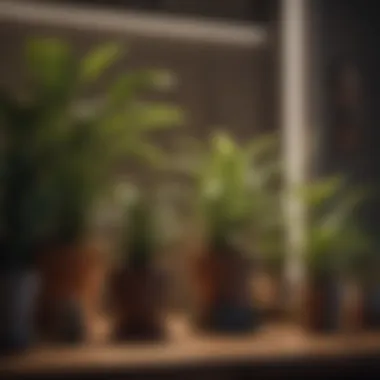
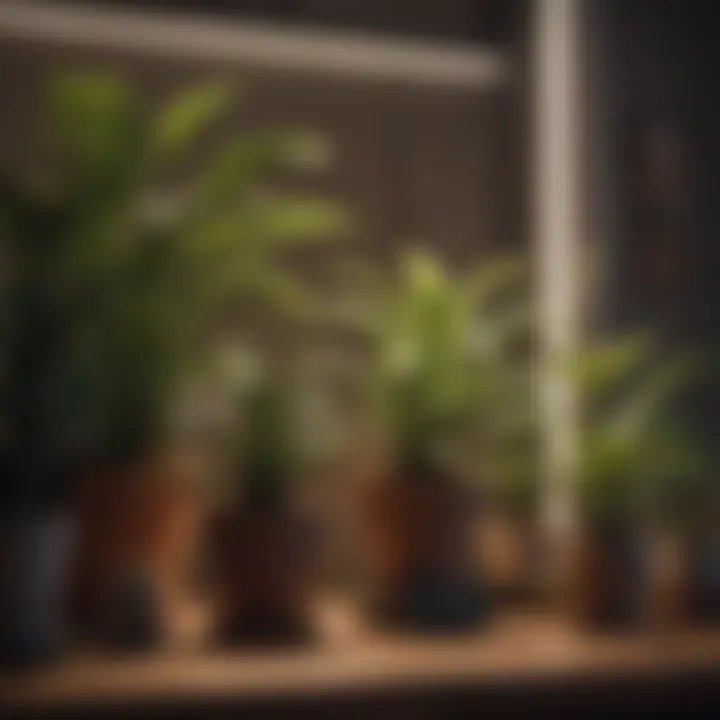
Daily Light Cycle Insights
Understanding the daily light cycle offers profound insights into plant needs. Most plants benefit from a cycle of 12 to 16 hours of light followed by dark periods that mimic the natural day-night rhythm. The crucial takeaway here is that too little light can hinder growth, while too much can cause stress or damage.
This careful management of light versing dark contributes greatly to the overall robustness of the plant's environment. Knowing when to flick that switch on or off will serve you well, ensuring full cycles and happier greens.
Automation Tips for Scheduling
Automating your grow light schedule is not just a luxury; it's practically a necessity for modern plant parents. Devices like timers or smart plugs can take the hassle out of manual operation, providing consistent lighting regardless of your busy lifestyle. One useful characteristic of scheduling automation is that you won’t risk forgetting to turn lights on or off.
Incorporating automation means freeing yourself from this mundane task while ensuring that your plants receive the perfect amount of light consistently. This reliability can lead to stronger growth and well-adjusted plants that are less prone to stress. Just remember, if machines are involved, regular checks are important to ensure everything is functioning smoothly.
Remember, proper setup of grow lights is not just about placement and timing; it’s about understanding your plants’ needs and adapting as they grow. Their happiness hinges on the little things you do!
With these strategies, the journey of setting up grow lights becomes clearer, simplified, and ultimately more effective.
Maintaining and Troubleshooting Grow Lights
Maintaining and troubleshooting your grow lights is a crucial element in ensuring that indoor plants thrive. Without a regular check-in on the condition and performance of these lights, your plants might face undesirable growth or even fatalities. This section addresses the significance of upkeep and common problems that users might encounter, along with solutions tailored to keep indoor ecosystems flourishing.
Regular Maintenance Practices
Keeping grow lights in top shape not only extends their lifespan but also enhances growing conditions for plants. Here are some regular maintenance practices that can help you stay on top of your grow lights:
- Cleaning: Dust and grime accumulate swiftly on grow lights, blocking light and lowering efficiency. Regularly wipe the bulbs and reflectors with a soft cloth and gentle cleaning solution to maintain optimal light output.
- Check Wiring: Inspect the power cords and plugs for any visible signs of wear or damage. Tattered cords can be a fire hazard and may cause inconsistent power supply.
- Monitor Temperature: Regularly assess the heat emitted from the grow lights. Adjustments might be necessary based on plant proximity.
- Replace Bulbs Periodically: Different types of lights have varying lifespans. For instance, fluorescent bulbs tend to lose their effectiveness after a year or so. Keeping an eye on when to replace them is vital. Look out for color discolorations or flickering as signs to swap them out.
Maintaining grow lights is not just about ensuring functionality; it creates a healthier environment for plants to grow. A seemingly small effort can yield lush results.
Common Issues and Solutions
-#### Mismatched Light Levels
Mismatched light levels refer to the discrepancy between the light intensity needed by plants and what they actually receive. This mismatch can drastically affect photosynthesis, leading to inadequate growth or even plant stress. For housewives and homeowners cultivating various plant types, recognizing and rectifying this issue is essential for a productive indoor garden.
An overly dim light setting might stunt the growth of high-light plants like succulents or tomatoes. On the flip side, excessive light can cause leaf burns, particularly for delicate plants like ferns.
To tackle this issue:
- Assess the specific light requirements for each species you're growing.
- Use light meters to gauge existing light levels, making adjustments as necessary to meet plant needs.
- Consider rotating plants to allow all of them to receive equal exposure to light.
-#### Heat Management
Heat management is another significant factor that can impact the performance of grow lights. High temperatures can reduce plant health and lead to bulb failure, making effective heat control necessary.
Most indoor gardeners might notice that lights generate varying amounts of heat; some light types exceed others. For instance, incandescent and HID lights produce considerably more heat compared to LEDs and fluorescents. Remember that this heat can lead to scorching leaves and impact humidity levels internally.
To manage heat effectively:
- Ensure proper airflow around the grow lights. Use fans to keep temperatures in check.
- Utilize cooling options like light shields or heat sinks especially with high-output lights.
- Monitor the temperature regularly in the grow area, adjusting the positions of the lights to maintain an optimal distance from plants.
In summary, consistent maintenance and troubleshooting of grow lights enable garden enthusiasts to curate an optimal environment for their plants. Recognizing issues like mismatched light levels and managing heat can elevate the growth experience substantially.
End and Final Thoughts
As we reach the end of our exploration into grow lights tailored for indoor plants, it’s critical to reflect on the insights gathered and their implications for both novice and seasoned gardeners. Understanding the dynamics of affordable grow lights not only enriches the indoor gardening experience but also enhances the ability to cultivate thriving plant life within one's home. With a myriad of options available, this knowledge arms individuals with the power to make informed choices, leading to healthier plants without the fiscal strain often associated with such pursuits.
The benefits highlighted throughout this article underscore the importance of selecting the right grow light based on specific needs—be it lighting spectrums, types of plants, or spatial arrangements. When cost-effective solutions are prioritized, one can strike a balance between plant care and financial prudence, making gardening a truly accessible hobby.
Ultimately, the journey into optimizing indoor plant growth through proper lighting is not just about illumination; it is about fostering an environment that allows plants to flourish and thrive.
"A well-lit plant is a happy plant, and a happy plant adds joy to your home."
Recap of Key Points
To summarize, let's revisit the essential elements covered:
- Understanding Grow Lights: Grasping what grow lights are and how they function is foundational for enthusiasts.
- Types of Grow Lights: Familiarity with various types such as LED, fluorescent, and incandescent aids in selecting the best option. Each type offers distinct benefits and limitations.
- Choosing the Right Grow Light: Knowledge about light spectrum needs, assessing light levels, and understanding space considerations can greatly influence plant growth.
- Best Affordable Grow Lights: Recommendations on specific products provide realistic paths to adopting effective lighting without overspending.
- Setting Up Grow Lights: Proper setup is vital for maximizing growth; distance and light duration play crucial roles.
- Maintaining and Troubleshooting Grow Lights: Regular maintenance and troubleshooting common issues ensure longevity and efficiency of the grow lights.
With this holistic view, readers are better equipped to make educated decisions, paving the way for flourishing indoor plants.
Encouragement for DIY Enthusiasts
For those eager to dabble in do-it-yourself projects, utilizing grow lights can be a gratifying venture. The satisfaction of fostering plant life from seedling to maturity can be unparalleled. DIY enthusiasts should not shy away from experimenting with various setups and types of lights.
Consider creating a mini greenhouse using recycled materials and affordable grow lights to truly customize your growing environment. Embrace trial and error as part of the learning journey.
- Start Small: Even a single potted herb can become a great starting point.
- Document Your Progress: Keeping notes can guide future projects and highlight what works or doesn’t.
- Engage with Community: Online forums like Reddit offer a wealth of collective knowledge from fellow growers.
By nurturing your plant babies in tailored environments, one not only contributes to the greenery of their home but can also enjoy the serenity and satisfaction that comes with indoor gardening. It’s a rewarding path that melds creativity with practicality, appealing to housewives, homeowners, and plant lovers alike.















